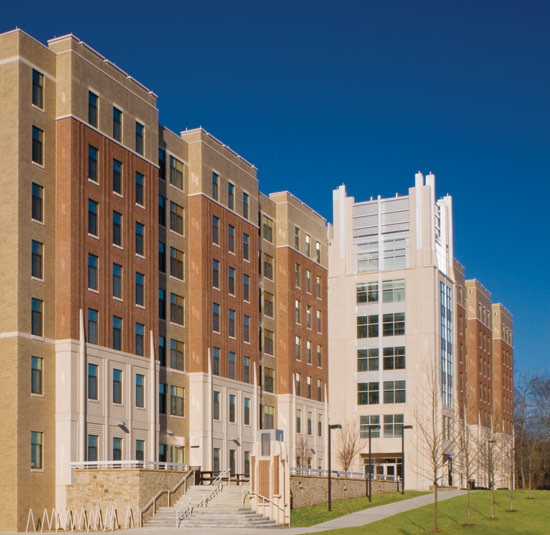Precast Concrete for High Performance Building Envelopes
Passive fire resistance. A total-precast concrete system provides an effective design for minimizing fire damage and containing the effects within the smallest space possible for the longest time. Concrete is noncombustible and can contain a fire within boundaries. As a separation wall, precast concrete helps prevent fire from spreading throughout a building or jumping from building to building. Noncombustible compartmentalization, combined with an inherently fire resistant/tolerant structural frame, provide the best combination of economics and protection that owners and users seek. When this passive design combines with other safety measures, including sprinklers and early-warning detection systems, a balanced fire protection design is achieved.
Disaster safety. Many schools and public facilities also serve as safe areas of community refuge during times of natural disasters, particularly those involving high winds such as tornadoes or hurricanes. Certified and approved precast concrete safe rooms and storm shelters have a role to play in providing secure areas for communities during severe weather, and comply with both FEMA 320 and FEMA 361, design criteria for residential and community safe rooms, respectively.
Case Study
| Dormitory at Catholic University Uses a Precast Sandwich Panel for Energy Efficiency | ||
|
The new eight-story, 127,000-square-foot dormitory on the Catholic University of America (CUA) campus, called Opus Hall, was developed by a design-build team that used precast concrete for thermal performance. The precast concrete envelope system was comprised of sandwich panels that include 3 inches of exterior concrete, embedded with thin brick, 2 inches of continuous insulation, and 5 inches of structural concrete with an exposed, steel-troweled interior finish, providing outstanding energy efficiency with material R-value of 14.25. By exposing the interior finish of the precast, the designers maximized the thermal mass benefits of the concrete. Preinsulated panels have edge-to-edge insulation and the layers of concrete are tied together with non-conductive connectors, eliminating thermal bridges. Effectiveness of the wall system was validated by a thermal imaging comparison of the completed project and nearby, masonry campus buildings. Carl Petchik, executive director of facilities operations for the university, estimates that it will cost CUA less to run the new building than it does to run both Millennium North and Millennium South residence halls. The project also features energy-efficient appliances and a high-performance HVAC system.
|
High-performance Envelopes—Strategies
By its very nature, precast concrete provides many high-performance attributes and, when precast concrete solutions are properly designed with effective building envelope strategies, designers can further enhance building performance.
Combination of Continuous Insulation, Air and Vapor Barriers in One System
With the advancement of energy codes, designers are approaching envelope design differently. Building envelopes in most regions of the United States must provide continuous insulation and a continuous air barrier. Envelopes also are required to provide a vapor barrier to control condensation and indoor humidity, as well as avoid compromising the insulation system. Precast concrete's edge-to-edge insulation, combined with the nonconductive connectors between the interior and exterior concrete layers, can create an efficient thermal break that prevents heat and moisture from penetrating the building and eliminates thermal loss and vapor transmissions present in other wall assemblies. With the addition of continuous insulation to precast concrete walls, which already provide an air and moisture barrier, this type of assembly effectively integrates the air, moisture, and heat management of the envelope into one efficient system.
Utilizing Concrete's Thermal Mass Potential
High-performance precast concrete sandwich wall construction is an efficient way to combine thermal mass and insulation in walls. To maximize the benefits of this, the interior side of precast concrete sandwich walls should be left exposed as the finished interior surface. Since precast concrete envelopes essentially have no thermal bridging, these attributes combined decrease indoor temperature fluctuations and enabling downsizing of HVAC systems and their associated first cost and long-term operational costs.
ASHRAE 90.1-2010 acknowledges the thermal mass benefits of concrete walls in specifying lower minimum insulation R-values and higher maximum wall U-factors for mass (concrete) wall construction in specific geographic areas. Essentially, the ASHRAE standard means that this type of assembly stores heat energy and registers better performance than the sum of its parts. That is, while the components of a wall individually add up to a material R-value, the mass wall performs at a much greater R-value—up to two times greater than that of the material itself. While the degree of improvement in R-value in a given structure is greatly dependent upon climate, occupancy type, building orientation, and other parameters, when used in the right combination, insulation and thermal mass, along with a building design that captures solar light and heat energy, can significantly improve thermal performance and lower energy requirements.
 |
The material R-value can be calculated by adding up the R-values of the materials that make up the assembly. In this example, the material R-value is R-11.65. However the actual performance R-value of this wall is greater due to thermal mass and no thermal bridging. Image by PCI |










